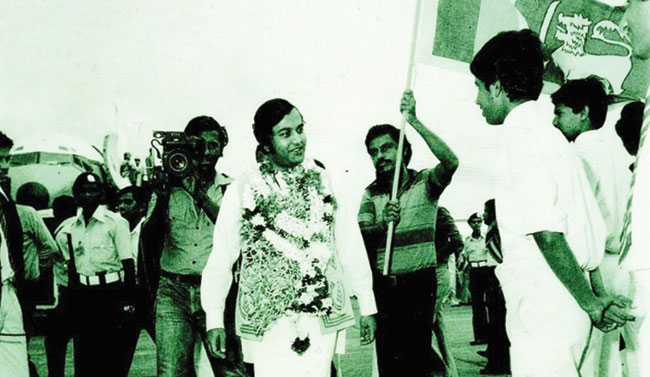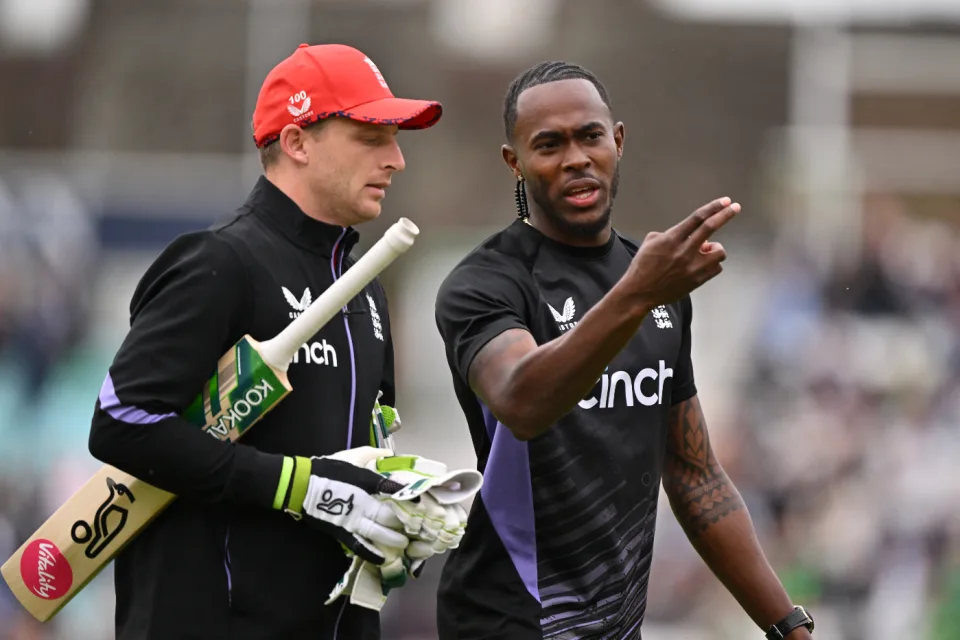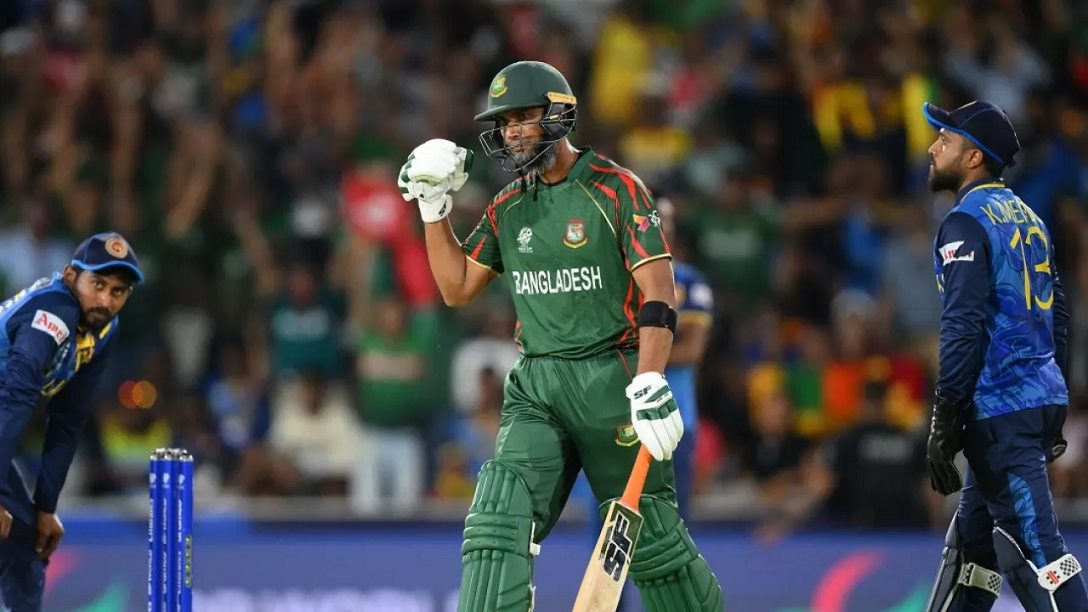Sports
Gamini – My friend

Today marks the 80th birth anniversary of visionary SLC President Gamini Dissanayake
by Nuski Mohamed
Gamini Dissanayae was my mentor and friend. My first interaction with him was in 1969 at the Institute of Chartered Accountants of Sri Lanka, when he was a lecturer in Company Law. Since then, we had been in close touch in terms of politics, cricket and corporate management.
In 1981 when Gamini was elected the President of the Board of Control for Cricket in Sri Lanka, I was the Treasurer. That was the year we famously became a Full Member of the International Cricket Council. Gamini’s leadership and the role he played towards Sri Lanka obtaining Full Membership is only too well known and need not be elaborated upon.
The following year, I was elected as Secretary of the Cricket Board and worked alongside Gamini until 1989 for a continuous period of seven years and was in constant contact with him. Gamini had a personality and a mind of his own, thought creatively and acted fearlessly. His leadership was unmatched. His decision making was precise in order to achieve timely and optimum results. One of those decisive moments was in 1982 when he took action with the blessings of the ExCo to ban the cricketers who went on the Rebel tour to South Africa for a period of 25 years without any hesitation whatsoever. It was an eye opener for younger generations.
Following the conclusion of the ICC meeting in 1985, over a coffee in the Long Room at the Lord’s Cricket Grounds, Gamini asked me whether I could take over the Chairmanship of the Sri Lanka Land Reclamation and Development Corporation almost overnight. It took me by surprise, since I knew that the responsibility of heading a State Corporation was demanding besides being a full time job. I was then with the Private Sector since the early 1970’s post qualified.
Although I was on a few Director Boards of State Corporations, the task of taking over a Corporation appeared to be a challenge. However, knowing Gamini’s thinking that he will not take ‘No” for an answer, I requested a few days’ time, to ponder over same.
But that was not to be and on our return to Sri Lanka two days later, he summoned me to the Ministry of Lands and issued me with the letter to take charge of the Corporation immediately. He had obviously made up his mind long before though it was not communicated to me. On hind sight it was a pleasure working with a personality of Gamini’s stature including the experience and knowledge I gained. We always had mutual respect for each other in our work ethics. I enjoyed every bit of our working relationship.
In the early to mid 1980s, the bid for the 1987 World Cup was a tussle between Australia/ New Zealand on the one hand and India/ Pakistan representing the Asian region. Australia had been very helpful to Sri Lanka in terms of exchange of tours which at that time was rare due to our not so strong cricket strength with the exit of key players on account of the rebel tour. Domestically too in coming tours were hampered as a result of the LTTE terrorist activity. Besides, the fact that Australia supported us positively during the crucial vote at ICC without exercising the veto following the visit of ACB Chairman Fred Bennet to Sri Lanka was foremost in Gamini’s mind.
In the midst of the ICC meeting Gamini mentioned to me that Sri Lanka should show some gratitude and thereby initiated a dialogue with the Aussie delegation which included David Richards, to explain to them the circumstances that will compel Sri Lanka to extend support to the bid from the Asian Region. This was well received and appreciated by the Australian delegates. Regional politics did eventually play a dominant role with the Prime Minister of India Rajiv Gandhi speaking to his Sri Lankan counterpart President J.R.Jayewardene and SLC had very little choice.
Gamini’s concluding speech on behalf of the Asian Region Countries on the concept that the World Cup should be rotated as a part of promoting the game globally received overwhelming applause and support from the ICC membership.
Lt. Gen Safdar Butt, President of the Pakistan Cricket Board was a great friend of Gamini. Lt.Gen Safdar was very commandeering and had a personality of his own. During the Pakistan tour of Sri Lanka in 1986 there was a fair amount of upheaval between the Sri Lankan umpires and the captain of the Pakistan team Imran Khan.
The current Prime Minister of Pakistan threatened to abandon the tour and take his team back home. That would have also jeopardized the Asia Cup in 1986 which was to immediately follow the Pakistan tour. Gamini using his personal friendship immediately phoned his counterpart Lt. General Safdar Butt who promptly took a flight and arrived in Sri Lanka at Gamini’s request to settle the dispute. Sanity prevailed and the tour continued with a change of Umpires for the final Test at the P. Sara Oval. A major catastrophe was thus averted.
Gamini never mixed cricket with politics. It was during our regime that the long felt need of a headquarters for the Cricket Board was identified and the project commenced at the SSC grounds. Gamini was able to negotiate terms with President J. R. Jayawardene who was also the President of SSC to construct the headquarters and the award was given to the State Engineering Corporation. We had no funds, but Gamini used his offices and found sponsors with the Sri Lanka Cricket Foundation, Gamini’s creation also chipping in.
During completion stage Turnor Wickremasinghe, Engineer in charge of the project at SSC told me that he would use light green and black paint to the front of the building and that he has consulted the Architects etc. They also opined it would blend well with the green grass in the background. As Secretary of the Board the State Engineering Corporation Consultants were in touch with me on a daily basis on all routine matters during construction and I gave the green light to go ahead.
A couple of weeks later, I happened to travel to the SLC with Gamini for a board meeting and he was fuming when he saw the external walls in a light green shade and questioned me as to whose bright idea it was to use green colour on the walls. I must say he was very polite and I admitted that I had given the go ahead since it came from the Architects. He requested me to get them to substitute the green colour immediately with white at whatever cost since the public perception would be that we used green as he was the President of the Board as it was his party colour. It remains white to date.
During the early 1980s, Gamini appointed me as the Treasurer of the Lanka Jathika Estate Workers Union with the blessings of HE the President when he took over the reigns of the Union as the President. He set out his program of work in such a manner always conscious of the fact that LJEWU being a Trade Union its paramount commitment should be towards the welfare of the members that is the plantation workers employed mostly in the tea, rubber and coconut plantations who were suffering untold hardships.
Gamini was particularly grieved to note that the worker’s relationship with the Estate Management left much to be desired. He realized a new dialogue was a pre requisite and it was time the Management recognised this new challenge. He succeeded in bringing about this change through persuasive powers which included seeking government intervention from time to strike deals for the estate workers beyond wage hikes. That was the hallmark of Gamini as a Trade Union leader.
Dame Betty Boothroyd, former Speaker of the House of Commons of the UK once said “From the numerous occasions that I have interacted with Gamini, it is clear that he has a huge vision for Sri Lanka and its people. While one could consider him an idealist, the very fact that he delivered in terms of the gigantic Mahaweli Project illustrates that he is also an extraordinary performer. It is a testimony to Gamini’s pragmatism and determination.
Finally, back to the Cricket Board Presidency, it is my view that he carried out his responsibilities with consummate ease and tact. He was well aware of the divide and the club rivalries in cricket, yet he always endeavored to make the Cricket Board a place that is accessible to all both players and administrators alike, so long as it was in the best interest of cricket. I am so proud and privileged to have been closely associated with Gamini, the personality who took Sri Lanka Cricket to such great heights during his regime.
Sports Editors’ note:
Mr. Nuski Mohamed was the right hand man of late Gamini Dissanayake having functioned as Secretary and Treasurer of the Board of Control for Cricket in 1980s. He served the cricket board up until 2015. He is still actively involved in cricket dedicating time to club cricket.
Sports
England face Australia in the battle of champions

The first truly heavyweight clash of this expanded T20 World Cup format comes freighted with both history and subplots. A rematch of the 2010 World T20 final at Kensington Oval, the match pits Jos Buttler’s defending champions – who are aiming to become the first team to retain the trophy – against the Australian winning machine, victors at the 2021 edition and current world title-holders in Test and ODI cricket. And that’s before you throw in the Ashes for afters.
Already there is added pressure on England, after the rain in Bridgetown led to a share of the points in their opener against Scotland (and that having conceded 90 runs from 10 overs without taking a wicket in a tepid bowling display). Lose to their oldest rivals and it will leave their Super 8 prospects open to being waylaid by the perils of net run-rate calculations, or worse.
The Scotland match was the third abandonment in five suffered by England, after a rain-affected home series against Pakistan, which has clearly hampered their readiness for this campaign after almost six months without playing T20 together. It does not take much for a side to click in this format – and England looked in decent shape when they did get on the field against Pakistan – but Buttler will be anxious for things to go their way on Saturday, if only to avoid further questions referencing the team’s disastrous ODI World Cup defence last year.
Australia, under the laidback leadership of Mitchell Marsh would love nothing more than to add to the English sense of jeopardy – having helped bundle them out of the tournament in India on the way to taking the crown. Their head to head record is less impressive in T20 however, with England having won six of the last seven completed encounters, as well as that 2010 final.
Despite a wobble with the bat, Australia avoided mishap against Oman earlier in the week, the experience of David Warner and Marcus Stoinis shining through in difficult batting conditions. Surfaces in the Caribbean – not to mention those games staged in the USA – have already had teams scratching their heads; rather than the “slug-fest” England had prepared for, following a high-scoring tour of the Caribbean in December, it looks as if boxing smart may be the way to go.
Speaking of Warner, this could be the last time he faces up against England in national colours – and another match-winning contribution would likely reduce the chances of them meeting again in the knockouts. On the other side of the card is Jofra Archer, fresh from an emotional maiden outing at Kensington Oval and ready to take on Australia for the first time in any format since 2020. Can Mark Wood fire up England’s campaign, as he did during last summer’s Ashes? Will Pat Cummins be back to harass the old enemy once again? Seconds out, it’s almost time to rumble.
Cummins is set to return after being rested for the Oman game, which saw Mitchell Starc leave the field with cramp. Starc is understood to be fine and could keep his place – which would likely see Nathan Ellis miss out. Marsh is still not fit to bowl, with Australia likely to continue with the allrounder combination of Stoinis and Maxwell to give them cover.
Australia (probable XI): David Warner, Travis Head, Mitchell Marsh (capt), Glenn Maxwell, Marcus Stoinis, Josh Inglis (wk), Tim David, Pat Cummins, Nathan Ellis/Mitchell Starc, Adam Zampa, Josh Hazlewood
The one change England may consider is Reece Topley coming in for Wood, with the expectation that there will be some rotation among the seamers through the course of the tournament.
England (probable XI): Phil Salt, Jos Buttler (capt & wk), Will Jacks, Jonny Bairstow, Harry Brook, Liam Livingstone, Moeen Ali, Chris Jordan, Jofra Archer, Adil Rashid, Reece Topley/Mark Wood
[Cricinfo]
Sports
South Africa up against their bogey team in batter-unfriendly New York

Once is coincidence, twice is a clue, and three times is proof.
To paraphrase Agatha Christie, that is the narrative around South Africa’s meeting with Netherlands at this T20 World Cup.
The Dutch beat South Africa at the 2022 tournament and ended their semi-final hopes in a match where South Africa appeared to be sleep walking, and then beat them again at the 2023 ODI World Cup, where they exposed South Africa’s vulnerability in the chase. If they to do the treble, not only will Netherlands take the lead in Group D, but they will offer conclusive evidence of the threat they pose to Full Members, especially South Africa.
Of course, it will take some doing after South Africa’s opening performance against Sri Lanka, where they reduced their opposition to their lowest T20I total and chased it down in fairly straightforward fashion thanks to the most stable middle-order of their white-ball era. In Aiden Markram, Tristan Stubbs, Heinrich Klaasen and David Miller, South Africa have bankers and big-hitters and, for this match, they also have the advantage of experience. They’ve already played at Eisenhower Park, and have first-hand knowledge that run-scoring doesn’t come easily;Klassen said they are prepared to use their “cricket brains” and play “smarter cricket”.
But the conditions could be good news for Netherlands, who are not naturally a line-up of big hitters and build their innings on a foundation of turning ones into twos. In other words, they tend to take a slightly more conservative approach to batting, which may work well here, but they’ll be wary of the uneven bounce of the surface and will have to come up with plans to counterattack especially against South Africa’s seamers. Their own bowlers were exemplary in Dallas and will look to build on that performance against a line-up that will likely be more proactive than Nepal’s, but who they have managed to keep quiet not once, but twice in the past. Third time’s the charm, they say.
Anrich Nortje’s stunning return to form against Sri Lanka means South Africa may not have to tinker with the bowling combination, and Gerald Coetzee and Tabraiz Shamsi may have to wait their turns to get a game. The batting line-up should be unchanged, with no space for Ryan Rickelton yet.
South Africa: Quinton de Kock (wk), Reeza Hendricks, Aiden Markam, Tristan Stubbs, Heinrich Klaasen (wk), David Miller, Marco Jansen, Keshav Maharaj, Kagiso Rabada, Ottneil Baartman, Anrich Nortje
Conditions in New York may tempt Netherlands to include an extra seamer and they have Kyle Klein in their squad. But it could come at the expense of a shortened batting line-up and they may not want to risk that.
Netherlands: Michael Levitt, Max O’Dowd, Vikramjit Singh, Sybrand Engelbrecht, Scott Edwards (capt, wk), Bas de Leede, Teja Nidamanuru, Logan van Beek, Tim Pringle, Paul van Meekeren, Vivian Kingma
[Cricinfo]
Latest News
Mustafizur, Rishad, Hridoy dazzle in Bangladesh’s tight two-wicket win over Sri Lanka

Nuwan Thushara’s last over brought Sri Lanka screaming back into the match,as he first bowled Rishad Hossain, and then nailed Taskin Ahmed in front of the stumps with a pinpoint swinging yorker. This left Bangladesh eight wickets down, with 12 runs still to get.
However, the experienced Mahmudullah was at the crease for Bangladesh, and despite some further nervy moments, pushed Bangladesh across the line off the last ball of the 19th over.
But this was a match chiefly decided by Bangladesh’s own outstanding bowling. Mustafizur Rahman was the best among them, using shorter lengths and his cutters efficiently, to claim figures of 3 for 17. Rishad Hossain’s three-for through the middle overs also kept Sri Lanka quiet.
Mustafizur was instrumental in Sri Lanka’s downward spiral through the middle overs, which culminated in a crash-and-burn end. Ultimately, their inability to find boundaries, or even rotate strike against good Bangladesh bowling resulted in their downfall. A score of 125 for 9 always seemed poor on a decent pitch, even if their bowlers made a match of it in the end.
Brief scores:
Bangladesh 125 for 8 in 19 overs (Towhid Hridoy 40, Litton Das 36; Dhanajaya de Silva 1-11, Nuwan Thushara 4-18, Wanidu Hasaranga 2-32, Matheesha Pathirana 1-27) beat Sri Lanka124 for 9 in 20 overs (Pathum Nissanka 47, Dhananjaya de Silva 21; Tanzim Hasan Sakib 1-24, Taskin Ahmed 2-25, Mustafizur Rahman 3-17, Rishad Hossain 3-22) by two wickets
[Cricinfo]












